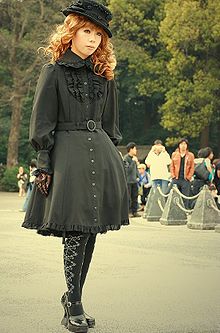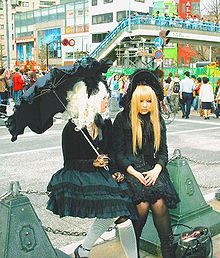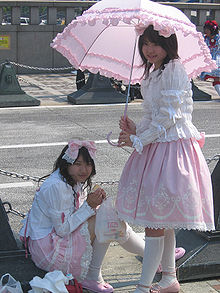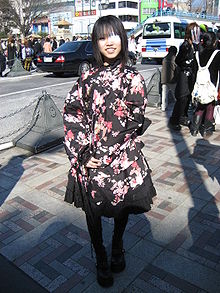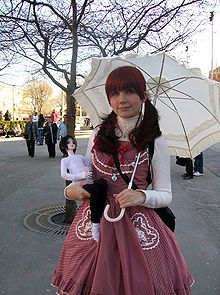- Lolita fashion
-
Lolita fashion (ロリータ・ファッション Rorīta fasshon) is a fashion subculture originating in Japan that is based on Victorian-era clothing as well as costumes from the Rococo period, but the style has expanded greatly beyond these two.[1] The Lolita look began primarily as one of modesty with a focus on quality in both material and manufacture of garments. The original silhouette is of a knee length skirt or dress with a 'cupcake' shape assisted by petticoats, but has expanded into various different types of garments including corsets and floor lengths skirts. Blouses, knee high socks or stockings and headdresses are also worn.[2] Lolita fashion has evolved into several different sub styles and has a subculture that is present in many parts of the world.
Although the origin of Lolita fashion is unclear, it is likely the movement started in the late 1970s when famous labels including Pink House, Milk and Pretty (later known as Angelic Pretty) began selling clothes that would be considered "Lolita" by today's standards. Shortly after that came Baby, The Stars Shine Bright, and Metamorphose temps de fille. In the 1990s, Lolita fashion became better recognized, with bands like Princess Princess and other bands coming into popularity at the time. These bands wore intricate costumes, which fans began adopting as their own style.[3] The style soon spread from its origins in the Kansai region, and ultimately reached Tokyo where it became popularized throughout Japanese youth culture. Today, Lolita fashion has grown so much in popularity that it can be found even in department stores in Japan.
Contents
The Term 'Lolita'
In the context of fashion, the term 'Lolita' does not have to relate to sex. The usage of the word may also be considered wasei-eigo or derives from the female given name, 'Lolita'.
The fashion was thought to have been partly created to react against the growing exposure of the body and skin in today's society, specifically in regard to young women. Adherents fight the current fashion with modesty presenting themselves as "cute" or "elegant" rather than "sexy".[4] One follower of the Gothic Lolita fashion explained:
We certainly do not do this for the attention of men. Frequently, female sexuality is portrayed in a way that is palatable and accessible to men, and anything outside of that is intimidating. Something so unabashedly female is ultimately kind of scary—in fact, I consider it to be pretty confrontational. Dressing this way takes a certain kind of ownership of one’s own sexuality that wearing expected or regular things just does not. It doesn’t take a lot of moxie to put on a pencil skirt and flats. It’s not, as some commentators have suggested, some sort of appeal to men’s expectation that women should be childlike, or an attempt to pander to pedophiles. Pedophiles like little girls. They don’t like grown women who happen to like dresses with cakes on them. I’ve never been hit on by a pedophile while in Lolita. We don’t get into it because it is some sort of misplaced pedo complex or anything, and the objective isn’t simply to emulate little girls, despite the name Lolita.[5]Influence and popularity
Lolita was influenced and popularized by the imagery of more feminine Visual Kei (or "visual art") bands. Visual Kei is a Japanese form of rock music defined by bands featuring performers in elaborate costumes but whose musical style varies. Mana, the cross-dressing former leader and guitarist of the Visual Kei band Malice Mizer is widely credited for having helped popularize Gothic Lolita. He coined the terms "Elegant Gothic Lolita" (EGL) and "Elegant Gothic Aristocrat" (EGA) to describe the style of his own fashion label Moi-même-Moitié, which was founded in 1999 and quickly established itself as one of the most coveted brands of the Lolita scene. Lolita has also influenced musical acts outside of Japan, most notably the band Razorbladekisses, who claim to be the only Visual Kei band from the UK. Major Japanese Children's franchise Pokémon has also shown Lolita fashion influence in regards to "Trainers" as well as the actual creatures. For example, three new Pokémon include Gothita, Gothorita and Gothitelle, all based on the Gothic Lolita influence.
Style types
Gothic Lolita
Gothic lolita, sometimes shortened to GothLoli (ゴスロリ gosu rori), is a combination of the Gothic and Lolita fashion.[citation needed] The fashion originated in the late 1990s in Harajuku.[6]
Gothic Lolita fashion is characterized by darker make-up and clothing. [7] Red lipstick and smokey or neatly defined eyes, created using black eyeliner, are typical styles, although as with all Lolita sub-styles the look remains fairly natural.[8] Though Gothic make-up is associated with a white powdered face, this is usually considered bad taste within the Lolita fashion.[9] Some Lolita uses dark color schemes including black, dark blues and purples, although black and white remains popular.[citation needed]. As with some Western Gothic styles, cross jewelry, religious symbols, bags and purses in shapes like bats, coffins, and crucifixes are also used to accessorize the Gothic Lolita look.[10]
Elegant Gothic Lolita (EGL) and Elegant Gothic Aristocrat (EGA) are substyles of gothic lolita (and of aristocrat fashion) hijacked by the visual kei rock musician Mana, in connection with his own fashion label Moi-même-Moitié.[11]
Japanese brands which exemplify the darker lolita style include Atelier-Pierrot, Atelier Boz, Black Peace Now, h. NAOTO Blood and Moi-même-Moitié.
Sweet Lolita
Sweet Lolita, also known as ama-loli (甘ロリ ama rori) in Japanese, is heavily influenced by Rococo styles as well as Victorian and Edwardian clothing. Focusing on the child and fantasy aspects of Lolita, the Sweet Lolita style adopts the basic Lolita format and uses lighter colors and childlike motifs in its design.
Makeup used in sweet Lolita is common throughout most Lolita styles. Pink, Peach, or Pearl make up styles are highly 'sweet' and used by many Sweet Lolitas. This look, paired with a shade of bright pink, red or sometimes nude-pink lipstick, is commonly used as well.
Outfits consist of pastels, fruit themes (cherries or strawberries, or any type of sugary fruit), flowers (roses, jasmines, lily, cherry blossoms) lace, bows, animal themes (cats, bunnies, puppies) and ribbons to emphasize the cuteness of the design. Popular themes in the sweet Lolita are references to Alice in Wonderland, sweets, and classic fairy tales. Jewelry often reflects this fantasy theme. Headdresses, bonnets and bows are a popular hair accessory to the sweet Lolita look. Bags and purses usually have a princess-like design and often take the shape of strawberries, crowns, hearts, and stuffed animals.
Examples for Sweet Lolita brands are Angelic Pretty, Baby, The Stars Shine Bright and Metamorphose temps de fille. Emily Temple cute (sister brand of Shirley Temple, a Japanese boutique), Jane Marple, and MILK are brands that carry more clothing that would be considered more casual, and are available to purchase at department stores in Japan.
Classic Lolita
Classic Lolita is a more mature style of Lolita that focuses on Rococo, Regency, and Victorian styles. Colors and patterns used in classic Lolita can be seen as somewhere between the Gothic looking and sweet styles; it is not as dark Lolita, but not as cutesy as sweet Lolita. This look can be seen as the more sophisticated, mature Lolita style because of its use of small, intricate patterns, as well more muted colors on the fabric and in the overall design.[12]
Designs containing a-lines, as well as Empire waists are also used to add to the more mature look of the classic style. Most classic Lolita outfits, however, still stick to the basic Lolita silhouette. Shoes and accessories are less whimsical and more functional. Jewelry with intricate designs is also common. The makeup used in classic Lolita is often a more muted version of the sweet Lolita makeup, with an emphasis placed on natural coloring. Classical Lolita brands include Juliette et Justine, Innocent World, Victorian Maiden, Triple Fortune, and Mary Magdalene.
Punk Lolita
Punk Lolita (or Lolita Punk) adds punk fashion elements to Lolita fashion. Motifs that are usually found in punk clothing, such as tattered fabric, ties, safety pins and chains, screen-printed fabrics, plaids, and short, androgynous hairstyles are incorporated into the Lolita look. The most popular garments are blouses or cutsews and skirts, although dresses and jumper skirts are also worn. Common footwear includes boots, Mary Janes or oxfords with platforms.[13] Common Punk Lolita brands are A+Lidel, Putumayo, h. NAOTO and Na+H. Many of the Japanese punk Lolita fashion brands take influence from London's famous Camden Town Markets. Vivienne Westwood, who, though not a Lolita designer, has items and collections that reflect Lolita sensibilities, especially in her Japanese collections, is popular in the punk Lolita scene. Males have known to take up Punk Lolita fashion, and as well as Victorian style Lolita fashion.
Other styles and themes
Because of the 'do-it-yourself' nature of Lolita fashion, many other themes have come out of the basic Lolita frame. These styles are often not as well known as the ones mentioned above, but they do showcase the creative nature of the Lolita fashion, and illustrate how people make the fashion their own.[14] Listed below are just a few examples of the smaller subtypes of Lolita fashion.
Princess Lolita
Hime (姫), or "Princess," Lolita is characterized by a princess-style look based upon the European aristocratic style.[15][16] This typically includes a tiara and a rococo style bustle back skirt. The style is often credited as being influenced by the Hime Gyaru trend that boomed in the late 2000s.
Shiro & Kuro Lolita
Shiro Lolita, or 'White Lolita,' is a Lolita outfit made entirely of white/cream/off-white co-ordinates, while its counterpart Kuro Lolita, or 'Black Lolita,' is an outfit made-up of entirely black co-ordinates. Shiro Lolitas often pair themselves with Kuro Lolitas in twin outfits to create an interesting contrast.[citation needed]
Shiro and Kuro Lolita can be taken from any style of Lolita, whether it be Gothic, Sweet, or Classic. If the co-ordination is completely white, then it is accepted as Shiro Lolita, while if it is entirely black it is accepted as Kuro.[citation needed]
Ōji Lolita (Boystyle)
Ōji (王子) or Ōji-sama (王子様), meaning "prince", is a Japanese fashion that is considered the male version of Lolita fashion. It does not follow the typical lolita silhouette but instead takes its influence from the Victorian era of young boys.[17] Though it is considered a "boy style", it may be worn by both genders.[citation needed]
Ōji Includes blouses and shirts, knickerbockers and other styles of short trousers, knee high socks, top hats, and newsboy caps. The colors usually used are black, white, blue and burgundy, though there are feminine versions of the fashion with a broader palette. Good examples would be some of the outfits sold through Baby, the Stars Shine Bright's line Alice and the Pirates.
Though in Japan this fashion is typically referred to as ouji, outside of Japan it is common to hear it referred to as "Kodona".
Guro Lolita
Guro Lolita (Gore Lolita) is the portrayal of a 'broken doll' or "Innocent Gore" by using items such as fake blood, make-up, and bandages to give the appearance of injury. It is suggested that Guro Lolitas wear white to "emphasize the contrast between purity and their wounds" or because blood contrasts better with white.
Sailor Lolita
Lolita fashion that incorporates the look of a Sailor. This can include sailor collars and ties, sailor hats, and stripes. Not to be confused with the common Japanese "seifuku" or sailor-style school uniform. Also popular is the related substyle "pirate lolita" with a similar nautical theme - this usually incorporates a more elaborate dress, styled with treasure chest bags, tricorns and eyepatches. Jewelry is heavily featured. "Alice & the Pirates" (a sub-label produced by "Baby the Stars Shine Bright") is a clothing brand which is well-known for its pirate-like aesthetic.
Country Lolita
Country Lolita is derived from the Sweet Lolita style, and is often a little hard to distinguish due to the use of the same sweet patterns and motifs that the Sweet Lolita style uses. However the Country Lolita style can be recognised by straw baskets, hats, fruit, and gingham patterns.
Wa Lolita
Wa rori (和ロリ), or Wa Lolita combines traditional Japanese clothing styles with the Lolita fashion. Wa Lolita usually consists of kimono or hakama modified to fit with common Lolita garments. The bottom half of the garment is altered to accommodate a petticoat, or a kimono-style blouse is used as a top to accompany a plain Lolita skirt. Outerwear can include haori or adult-sized hifu-vests. The shoes and accessories used in this style are typical of traditional Japanese garb including kanzashi flowers, and geta, zori, or Okobo. These shoes are often used in place of the normal Lolita platform and high-heeled shoes.[citation needed] The origin of the prefix Wa in Wa Lolita is the kanji Wa (和), which is used to denote many things of Japanese origin.[citation needed]
Qi Lolita
Qi Lolita is a similar style but uses Chinese clothing and accessories in place of Japanese. Usually this includes qipao dresses modified to accommodate a petticoat. Accessories include platform-slippers for footwear and bun-covers as hair accessories.[citation needed]
Casual Lolita
Casual Lolita is less of a style in and of itself but is used to describe a 'toned down' approach to the lolita fashion. While the basic lolita elements are still adhered to, the key element in the casual lolita co-ordination is simplicity. An example being a a simple cut-sew with a motif of some sort paired with a lolita skirt and hair accessory. Casual Lolita styles can be compiled out of any colours, so long as one remembers to match styles, colours and prints appropriately. Casual Lolita can best be described as what a Lolita would wear when not 'dressing up': Still modest and elegant, but not to the degree of most other Lolita styles.
Outside Japan
Outside Japan, the Lolita fashion, along with cosplay and other Japanese cultural phenomena, can sometimes be seen at concerts and anime conventions throughout North America (see Anime North), the UK, Ireland, Germany, Australia, Mexico, New Zealand, Brazil, Argentina, Chile, France, Belgium, Italy, Russia, Sweden, Denmark, the Netherlands, and the rest of the planet. It is, however, becoming increasingly popular as an everyday subculture style. The style is not mass marketed outside of Japan, though small stores have emerged, including "One Day in Paradise" in central Melbourne. Baby, The Stars Shine Bright and Angelic Pretty both have stores in Paris and San Francisco, there is also a shop called Mirai Fashion in the Netherlands that sells several brands.
Major brands, such as Metamorphose temps de fille, Angelic Pretty, h. Naoto, Baby, The Stars Shine Bright and Moi-même-Moitié have recently shipped goods to the international market. This is still not widespread, however, and many of the clothes produced by non-Japanese designers are not accepted by the Lolita community for being inaccurate in portraying the style and not being as high-quality as the Japanese brand clothes. However, there is a growing group of dedicated western Lolita fans who wear Lolita clothing on a semi-regular or even a day-to-day basis. Celebrity author Novala Takemoto, an important figure within Lolita culture, traveled to America in 2006 and remarked at a panel on the resourcefulness of western Lolitas, who often make or adapt their own clothing. Outside of Japan there are numerous Lolita groups that will come together and have tea parties, talk and have fun. Lolita magazines are a widely available resource, purchased on the internet and at Japanese bookstores which also deal in anime and manga. The Gothic and Lolita Bible briefly had an American version which featured translated content from the original magazine alongside content from a small but growing group of western Lolita designers from around the world such as Candy Violet, Fanplusfriend, In the Starlight, Blasphemina's Closet, Sweet Rococo, and Megan Maude.
In popular culture
These lists display stories which have either characters wearing some form of Lolita fashion or character designs influenced by the fashion.
Anime
- Le Portrait de Petit Cossette[18]
- Paradise Kiss[19]
- Princess Princess[20]
- Shiki[21]
- Tsukuyomi: Moon Phase[22]
Manga
- Doors of Chaos[23]
- IC in a Sunflower[24]
- Othello[25]
- R.I.P.: Requiem in Phonybrian[26]
- Rozen Maiden[27]
- The Embalmer[27]
Video Games
Monster High in the doll line Monster High by Mattle Draculaura wears outfits in the Lolita style, specifically her 2ed outfit which is Black, Pink, Yelloqw and White
Gothic & Lolita Bible
One magazine in particular, the seasonally published Gothic & Lolita Bible, has played an instrumental role in promoting and standardizing the style. First published in early 2001,[28] the 100+ page magazine includes fashion tips, photos, sewing patterns, catalog descriptions, decorating ideas, and recipes. Tokyopop released an English-language version of the magazine in February 2008, but discontinued it after it failed to garner many sales.[29]
References
- ^ Jimenez, Dabrali (26 September 2008). "A New Generation of Lolitas Makes a Fashion Statement". The New York Times. http://www.nytimes.com/2008/09/28/nyregion/thecity/28trib.html?_r=2&oref=slogin. Retrieved 13 February 2010.
- ^ Ishikawa, Katsuhiko, Gothic & Lolita, Phaidon, 2007, pp 13, 89, 93 et al.
- ^ Ishikawa, Katsuhiko, Gothic & Lolita, Phaidon, 2007, p 1
- ^ "What Is Lolita". http://www.lolitafashion.org/what_is_lolita.php.
- ^ MacDonald, Heidi (1 October 2008). "A Gothic Lolita Speaks". Publishers Weekly. http://pwbeat.publishersweekly.com/blog/2008/10/01/a-gothic-lolita-speaks/. Retrieved 13 February 2010.[dead link][dead link]
- ^ http://uni.opole.pl/~wanke/masowe/Yuniya_Kawamura_-_Japanese_teens_as_producers_of_street_fashion_-_Current_Sociology_5_2006.pdf
- ^ Aoki, Deb. "Interview with the Editors of the Gothic and Lolita Bible". About.com. http://manga.about.com/od/mangaartistswriters/a/JWinterberg.htm. Retrieved 10 May 2010.
- ^ Anonymous (2002). "Gothic Lolita Hair and Make Up". Gothic & Lolita Bible (Nuuberuguu) 4: 79.
- ^ Anonymous (2002). "Neo Gothic Style". Gothic & Lolita Bible (Nuuberuguu) 4: 81.
- ^ Anonymous (2002). "Gothic and Lolita: New Style". Gothic & Lolita Bible (Nuuberuguu) 4: 102.
- ^ Anonymous (2002). "Artist Brands: Part 1, Mana x Moi-mene-Moitie". Gothic & Lolita Bible (Nuuberguu) 4: 23.
- ^ Anonymous, “Neo Lolita Style”, Gothic & Lolita Bible, vol 4, Nuuberuguu, 2002, pg 80
- ^ “IMF's ‘Local Feed’ Tokyo - Lolita Fashion” July 03, 2007 http://www.youtube.com/watch?v=daUWU2C9yFo
- ^ Saramaki, Rinna, “From Boring to Beautiful”, La Vie en Rose, vol 2, pp. 21–24.
- ^ For Lolitas of All Styles. Lolita Fashion. Retrieved on 2010-03-24.
- ^ Kane, Yukari Itawari; Lisa Thomas (20 November 2008). "Japan's Latest Fashion Has Women Playing Princess for a Day". The Wall Street Journal. http://online.wsj.com/article/SB122713804938242481.html. Retrieved 13 February 2010.
- ^ Seagrave, Amber, "Style: Kodona," La Vie en rose, vol.2, p.18
- ^ Martin, Theron (15 September 2005). "Petit Cossette DVD 1 - Review -". Anime News Network. http://www.animenewsnetwork.com/review/petite-cossette/dvd-1. Retrieved 21 October 2009.
- ^ Bertschy, Zac (20 October 2005). "The Fall 2005 Anime Preview Guide". Anime News Network. http://www.animenewsnetwork.com/feature/2005-10-20. Retrieved 10 March 2010.
- ^ Brienza, Casey (15 January 2009). "Princess Princess DVD Complete Collection - Review". Anime News Network. http://www.animenewsnetwork.com/review/princess-princess/dvd-complete-collection. Retrieved 1 March 2010.
- ^ Finnegan, Erin (19 July 2010). "Germ Theory - Shelf Life". Anime News Network. http://www.animenewsnetwork.com/shelf-life/2010-07-19. Retrieved 19 July 2010.
- ^ Kimlinger, Carl (14 February 2007). "MoonPhase DVD 3". Anime News Network. http://www.animenewsnetwork.com/review/moonphase/dvd-3. Retrieved 1 March 2010.
- ^ Sparrow, A.E. (8 April 2008). "Doors of Chaos: Volume 1 Review". IGN. http://au.comics.ign.com/articles/865/865084p1.html. Retrieved 20 July 2010.
- ^ Thompson, Jason (4 December 2009). "365 Days of Manga, Day 80: IC in a Sunflower". Suvudu. http://www.suvudu.com/2009/12/365-days-of-manga-day-80-ic-in-a-sunflower.html. Retrieved 10 March 2010.
- ^ Cha, Kai-Ming (27 September 2005). "Sweet and Sour in a Frilly Dress: Gothic Lolita Hits the U.S.". Publishers Weekly. Archived from the original on 11 December 2008. http://replay.waybackmachine.org/20081211115323/http://www.publishersweekly.com/article/CA6260746.html. Retrieved 13 February 2010.
- ^ Harper, Melissa (27 December 2006). "R.I.P. - Requiem in Phonybrian - Review". Anime News Network. http://www.animenewsnetwork.com/review/r.i.p-requiem-in-phonybrian. Retrieved 29 March 2010.
- ^ a b Muray, Laurel (5 February 2008). "Lolita Culture: An Introduction". Publishers Weekly. Archived from the original on 15 May 2008. http://web.archive.org/web/20080515231917/http://www.publishersweekly.com/article/CA6528711.html. Retrieved 13 February 2010.
- ^ Amazon.co.jp: ゴシック&ロリータバイブル (バウハウスMOOK): 本. Amazon.co.jp. Retrieved on 2010-03-24.
- ^ "Tokyopop to Ship Gothic & Lolita Bible in February". Anime News Network. 4 December 2007. http://www.animenewsnetwork.com/news/2007-12-04/tokyopop-to-ship-gothic-and-lolita-bible-in-february. Retrieved 13 February 2010.
External links
- Hello Lace—Lolita resources and style guides
- Avant Gauche—Lolita Shop Reference and Image Galleries (Somewhat outdated.)
- Lolita Fashion—Lolita Fashion in Asia
- Lolita Tips-Tips and Advice for those interested in Lolita
- Lolita Handbook—Guide to Lolita fashion on Livejournal
Japanese subcultures Subcultures Cultural phenomena Categories:- Fashion aesthetics
- Gothic fashion
- History of fashion
- Japanese fashion
- Japanese subcultures
- Japanese words and phrases
Wikimedia Foundation. 2010.

